|
New Territories |
|
| |
Tai Po Kau Nature Reserve
Shing Mun Reservoir
Ho Chung Valley
Ng Tung Chai
Wun Yiu
Tai Mo Shan
Sha Lo Tung
Mai Po Nature Reserve
Tsim Bei Tsui
Starling Inlet (Luk Keng and Nam Chung)
Kam Tin
Long Valley
|
|
| |
Tai Po Kau Nature Reserve
Lying between the Tai Po market and the Chinese University of Hong Kong, the Tai Po Kau Nature Reserve is one of the most mature secondary forests in Hong Kong. The forest embraces secondary forest, vegetation and native trees, so it is the best place to view forest birds like flycatchers, minivets, warblers and thrushes. Local birders often prefer short routes like red path and blue path.
Target species: Hainan Blue Flycatcher、Tristram's Bunting、Pygmy Wren Babbler、Yellow-cheeked Tit、Forest Wagtail、Orange-bellied Leafbird、White-bellied Yuhina、Velvet-fronted Nuthatch、Scarlet Minivet、Blue-winged Minla、Japanese Paradise Flycatcher、Fork-tailed Sunbird
Estimated time required: About 4 hr
Transportation: Take route no. 72 (KMB)、no. 73A(KMB) or no. 74A(KMB) from Tai Po Market and get off at the "Chung Tsai Yuen" stop, cross the road to the other side and walk until along the concrete road; Alternatively, take a taxi from Tai Po Market MTR station and ask the driver to stop at "Chung Tsai Yuen". Walk uphill along the concrete road to the reserve.
Map
Back to top
|
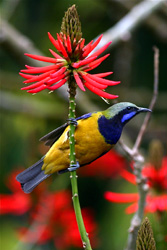
Orange-bellied Leafbird (by Gary Chow) |
| |
Shing Mun Reservoir
Shing Mun Reservoir is located at the southwestern side of Tai Po Kau, therefore many species appearing in Tai Po Kau can also be found here. Birdwatching here is convenient attributable to the extensive network of footpaths. The Tai Shing stream also enlivens the reservoir, making it one of the best birdwatching spots. It is possible to go from here to Tai Mo Shan, Tai Po Kau and Ng Tung Chai, but a map is a prerequisite for personal safety.
Target species: Hainan Blue Flycatcher、Black-throated Tit、Velvet-fronted Nuthatch、Grey-throated Minivet、Scarlet Minivet、Rufous-capped Babbler、Streak-breasted Scimitar-babbler、Fork-tailed Sunbird
Estimated time required: About 3 hr
Transportation: Take green mini-bus no. 82 at Shiu Wo Street in Tsuen Wan (near to the Tsuen Wan MTR station)
Back to top
|
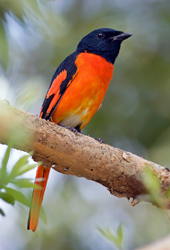
Scarlet Minivet (by Ng Lin Yau) |
| |
Ho Chung Valley
Ho Chung Valley is situated in Sai Kung (the eastern side of Kowloon Peak), upper side of which is a small woodland while the lower part is open field. The woodland of Ho Chung Valley is therefore a good place to observe passage migrants during autumn and winter. There is also an abundance of species of open fields.
Target species: Grey Treepie、Hair-crested Drongo、Chinese Goshawk、Dollarbird、buntings
Estimated time required: About 3 hr
Transportation: Take red mini-bus route no. 1 bound for Sai Kung at Exit C2 of Choi Hung MTR station and get off at Ho Chung (on the opposite of Marina Cove); Alternatively can take green mini-bus route no. 101M bound for Sai Kung at Exit B1 of Hang Hau MTR station and get off at Ho Chung
Map
Back to top
|
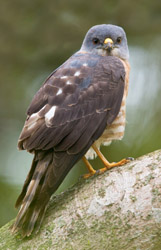
Chinese Goshawk (by Allen Chan) |
| |
Ng Tung Chai
Ng Tung Chai refers to the small valley between the southern part of Lam Tsuen valley and the foot of Tai Mo Shan. The birding environment here is good particularly in the area between the first and the second waterfalls where various species of warblers, flycatchers and thrushes can be found.
Target species: Lesser Shortwing、Crested Serpent Eagle、Grey Treepie、Scarlet Minivet、Ashy Drongo
Estimated time required: About 4hr
Transportation: Take bus route no. 64K (KMB) from Tai Wo MTR station and get off at the "Ng Tung Chai" stop
Back to top
|
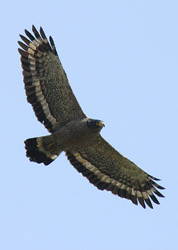
Crested Serpent Eagle (by Wong Yiu Hing) |
| |
Wun Yiu
Located at the southwestern side of Tai Po market, Wun Yiu used to be the base of ceramics in the New Territories and an important cultural heritage of Hong Kong. Wun Yiu has many trees while the Wun Yiu river is also a rather birdy spot.
Target species: White-browed Laughingthrush、 Plumbeous Redstart、Scarlet-backed Flowerpecker、Phylloscopus warblers、Blue Magpie
Estimated time required: 1 hr
Transportation: Take green mini-bus route no. 23K at the Lion Club Youth Centre at Po Heung Street in Tai Po town and get off at Wun Yiu
Back to top
|
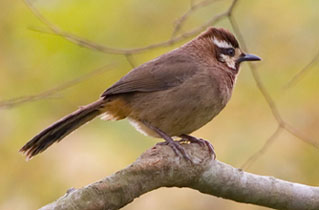
White-browed Laughingthrush (by Owen) |
| |
Tai Mo Shan
As the highest mountain in Hong Kong (around 1,000 m), habitats in Tai Mo Shan include shrubs and grass slopes, thus it is a place to look for upland species. The scenery of Kam Tin and Deep Bay is also visible from here.
Target species: Upland Pipit、Vinous-throated Parrotbill、Chinese Francolin、Chinese Barbax、Large Grass Warbler、Crested Bunting、Grey-faced Bunting、Bonelli's Eagle、Lesser Coucal
Estimated time required: About 3 hr
Transportation: Take route no. 51 (KMB) at the Tsuen Wan MTR station and get off at the "Country Park" stop then walk uphill; Alternative way is to take a taxi to the gate near to the summit of Tai Mo Shan and walk uphill/downhill for birding
Back to top
|
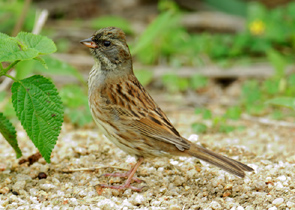
Black-faced Bunting (by Isaac Chan) |
| |
Sha Lo Tung
Sha Lo Tung is worth a visit in all seasons. This valley near to Tai Po has a diversified habitats from Fung Shui woods, streams to grass lawns. Sha Lo Tung is designated as a Site of Special Scientific Importance (SSSI) and it is a good place to look for various species of bush warblers and robins. It also provides suitable habitats for many species of butterflies and dragonflies.
Target species: Bright-capped Cisticola、Russet Bush Warbler、Grey Treepie、Chestnut Bunting
Estimated time require: About 3 hr
Transportation: Take route no. 75K (KMB) at Tai Po Market MTR station and get off at "Yue Kok" stop. Proceed in the direction of Tai Mei Tuk and turn left to Fung Yuen Road at the first junction, or turn left to Sha Lo Tung Road at the second junction. Both ways end up in Sha Lo Tung.
Location map of the bus stop
Route map
Back to top
|
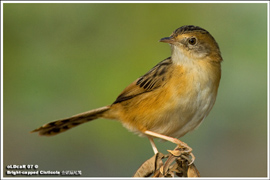
Bright-capped Cisticola (by oLDcaR) |
| |
Mai Po Nature Reserve
As a wetland of international importance, Mai Po Nature Reserve at the northwestern outskirt of Hong Kong has been widely acclaimed as a superb birdwatching spot as managed by WWF Hong Kong. Mai Po Nature Reserve is an important feeding ground for passage and winter migrants, most of which are wetland birds. In spring a great number of waterbirds and shorebirds arrive at Mai Po to feed, while the Reserve is also the stronghold of different species of ducks and egrets. The Reserve comprises mangroves, shallow shrimp ponds (gei wais), freshwater swamps and dredging ponds with a number of birdwatching hides. The hides on the mudflat facilitate birdwatchers to view the spectacular scene of shorebirds approaching to feed on the mudflat when tides go up or down. The satisfactory height of tide is 2.2 m for birdwatching at the hides on the mudflat. Birders may check the latest tide time table of Tsim Bei Tsui from the website of the Hong Kong Observatory in advance.
Target species: Chinese Egret、Black-faced Spoonbill、Dalmatian Pelican、Saunder's Gull、Spoon-billed Sandpiper、Asian Dowitcher、Nordmann's Greenshank、Imperial Eagle、Greater Spotted Eagle
Estimated time required: About 5 hrs
Transportation: Take route no. 76K (KMB) at Yuen Long and get off at the "Mai Po" stop, then walk along the Tam Kong Chau Road for 20 mins to Mai Po; Alternatively, take red mini-bus route no. 17 which goes between Shui Che Kwun Street in Yuen Long and San Fat Street in Sheung Shui and get off at Mai Po, then walk along the Tam Kong Chau Road for 20 mins to Mai Po
Location map of bus stop
Route map
Back to top
Note: Mai Po is both a nature reserve and a frontier area. Visitors should present their "Mai Po Marshes Permit" at the Nature Warden's post of Agriculture, Fisheries and Conservation Department upon arrival.
|
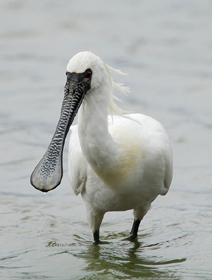
Black-faced Spoonbill (by Chan Kui Fai) |
| |
Tsim Bei Tsui
Tsim Bei Tsui has a varied mix of habitats including tidal ponds, fish ponds, egretries and woods on the roadside for different bird species. As Tsim Bei Tsui is adjacent to Mai Po Nature Reserve, this is another location to view various species of waterbirds. Walking along the barbed wire fence, one can reach a metal bridge located within the boundary of the wetland of international importance. The view at this point is wide and is a good spot for watching waterbirds. On the right hand side of the bridge is a path leading to Mong Tseung Wai which has a small patch of woods, abandoned fields, fish ponds and orchard. The small terrain next to the pavilion of Tsim Bei Tsui is a good spot to observe birds of prey.
Target species: Black-faced Spoonbill、Dalmatian Pelican、Slaty-breasted Rail、Grey-headed Lapwing、Oriental Pratincole、Crested Serpent Eagle、Imperial Eagle、Greater Spotted Eagle、Eurasian Eagle Owl、Blue-capped Kingfisher
Estimated time required: About 4 hrs
Transportation: Take green mini-bus no. 35 at Tai Fung Street in Yuen Long and get off at Tsim Bei Tsui
Back to top
|
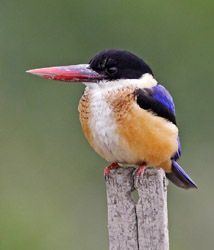
Blue-capped Kingfisher (by C.Y. Sin) |
| |
Starling Inlet (Luk Keng and Nam Chung)
Starling Inlet bears the largest egretry in the territory. Every end March to August, over 6 species of egrets breed in the egretry on the small island (A Chau) on the southwestern side of Yim Tso Ha and Starling Inlet. The view is spectacular. On the other side of the gulf, there remains the pristine view of Nam Chung valley and freshwater marsh of Luk Keng. This is the best place to spot species of open field and wetland (e.g. kingfishers, bitterns and egrets etc.).
Target species: Cattle Egret、Great Egret、Blue-capped Kingfisher、Pied Kingfisher、Black Baza
Estimated time required: About 2 hrs
Transportation: Take green mini-bus route no. 56K at the Fanling MTR station and get off at Luk Keng terminus
Map
Back to top
|
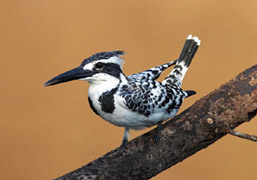
Pied Kingfisher (by C.Y. Sin) |
| |
Kam Tin
Located at the east of Yuen Long town, Kam Tin is composed of abandoned fields, a polluted stream, some fish ponds and some fields. Roams of water buffaloes used to wander in this area. Following the frequent occurrence of nuisance caused by illegal dumping of construction wastes, the population of water buffaloes dropped and the wetland turns dry gradually. The situation is worrying.
Target species: Grey-headed Lapwing、Greater Painted Snipe、Richard's Pipit、Siberian Stonechat、Red-billed Starling
Estimated time required: About 2 hrs
Transportation: Take route no. 64K (KMB) at Yuen Long and get off at the "Mung Yeung School" stop, then proceed to the buffalo field from the path on the right hand side of the school
Map
Back to top
|
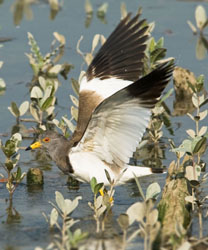
Grey-headed Lapwing (by Kitty Ku) |
| |
Long Valley
Long Valley is a flood plain at the northwest of Sheung Shui MTR station with an area of 25 hectares. Apart from wet fields cultivating water cress and water spinach, the site has a composite of different micro-habitats including blood worm ponds, lotus ponds, fruit trees margining the fields and gullies etc. It is renowned as the “second Mai Po” for over 250 bird species have been recorded here up to now.
Target species: Greater Painted Snipe、snipes、Zitting Cisticola、Richard's Pipit、Red-throated Pipit、Bluethroat、Red-billed Starling、Cattle Egret
Estimated time required: About 2-3 hrs
Transportation Take green mini-bus route no. 51K at the mini-bus stand between Sheung Shui MTR station and Landmark North and get off at the terminus in Ho Sheung Heung, then walk for about 3 mins in the direction to Beas River, cross the Beas River bridge and reach Long Valley
Map
Back to top
|
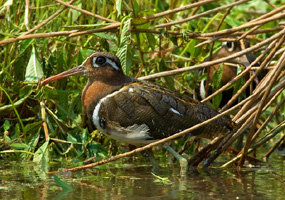
Greater Painted Snipe (by oLDcaR)
|
| |
|
|
| |
|
|
| |
|
|